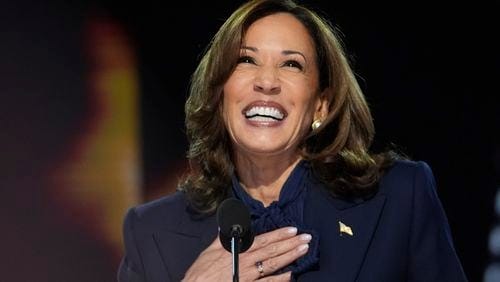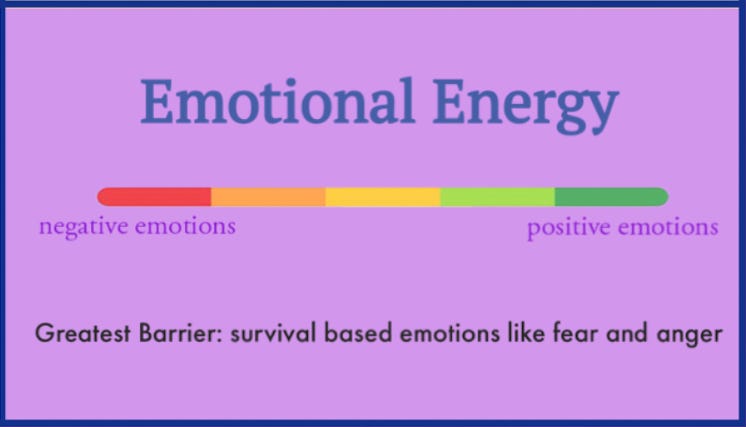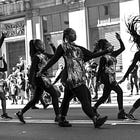NEWSFLASH: Men are emotional too!
Why emotional stability is a core qualification for leadership
Please don’t cry. Please don’t cry. Please don’t cry.
That’s what I kept repeating in my mind as Vice President, Kamala Harris, tried to quiet the DNC crowd before she gave her nomination acceptance speech last week. The ovation from the audience lasted quite some time. Long enough that most people would be touched by the love and tears would begin to well up in their eyes. Personally I think there is nothing wrong with her being moved to tears had that happened, but our persnickety media and her political opponents would never let us hear the end of it.
A few days prior to her acceptance speech while scrolling my TikTok feed, I came across a video of a young lady talking about how women were too emotional for the presidency. Of course, this not some new sentiment but I didn’t expect to hear that outdated idea in 2024 from a young 20-something.

It’s interesting, even with a greater focus on mental health and the rising popularity of therapy, how limited we still are when it comes to our emotional development and how we talk about emotions. The term “emotional” is primarily used when someone is crying or getting choked up. I rarely hear the term “emotional” for any other expression of emotion. I vaguely remember the term “emotional” being used when R. Kelly essentially threw a tantrum in his interview with Gayle King several years ago.
Some time ago, I commented on a LinkedIn post where a man was saying how coaches don’t deal in emotion and that they are always able to make logical decisions on how to approach a particular game. My first thought was, has this guy ever watched any sports commentary or seen how these athletes, especially professional athletes, behave? Coaches have to manage the personalities of their athletes and many of these athletes very much lead with emotion. If you don’t believe me then read the book, Eleven Rings: The Soul of Success, by legendary NBA head coach, Phil Jackson.
The fact is every human being has emotions and thus emotional. Social scientist, Brene Brown, in her book, Atlas of the Heart, describes 87 different emotions she uncovered in her research. Probably one of the most beneficial exercises clients experience during therapy is identifying their true feelings beyond being happy, mad, and sad.
The issue is which emotions are deemed acceptable to express and the double standards of who is allowed to express each emotion. Men typically are not permitted to cry but are usually allowed to express anger and aggression. Women typically are allowed to cry but are not considered emotionally strong enough for certain roles. Women often are not considered tough enough to lead men. That is here in the United States. Presumably if our Vice President wins the general election, that false narrative will be debunked once and for all. We shall see…
The double standard not only applies between the sexes but usually along racial lines within the sexes. Black people typically are not permitted to show anger and sorrow but expected to show deference, gratitude, and submission. People of color in general are not typically shown empathy. Anytime we as a society want to trigger empathy, the pained white female face is what we typically need to see.
What’s also odd to me is how we track our cognitive development pretty closely but our emotional development is largely unaccounted for. It’s not until we encounter a problem that we begin to address any emotional deficiencies. Courts often order anger management classes for defendants with low level offenses. Outside of any precipitating events, it is largely up to us individually to monitor our emotional development and many times we don’t even know how to gauge it. We usually abide by the examples set before us or what we were socialized to believe was acceptable or unacceptable.
When it comes to emotional development between men and women, women are considered to be better at verbally expressing their emotions and men are often prodded to open up verbally. Verbally is the operative word here, because our emotions are also expressed non-verbally, physically even violently.
However, for emotional balance or emotional stability, we are supposed to experience and verbalize the full gamut of emotions. Our emotional energy is off balance when we lack vulnerability and primarily operate from survival based emotions like fear and anger.
When it comes to emotionally stable leaders, we tend to think they are stoic and unemotional. And the only appropriate emotions to express are those that indicate toughness during times of crisis and conflict. If they were to express any other emotion, particularly one that leads to tears, then they risk being seen as emotional or too sensitive.

When it comes to engaging other people, especially the masses, we expect our leaders to contain their emotions. To me that’s what we actually mean when we call someone emotional—they can’t contain or control their emotions, particularly when crying is involved. But to be emotional would be to lack control of any emotion. Many people, especially men, have uncontrolled anger. For whatever reason, anger is always called out separately and we tend to forget that it is indeed an emotion. The class is called Anger Management not Emotion Management, even though how to manage our emotions is what is ultimately taught in the class.
Controlling our emotions is an element of emotional stability but not emotional stability in and of itself. We have to both experience and express the full range of emotions available to us. Some of that expression needs to occur within safe spaces. For example, when the awful, senseless and tragic elementary school shooting in Newtown, Connecticut occurred, then President Obama was so distraught that he sent for his wife, First Lady Michelle Obama. For that level of emotion, she was his safe space to express his true feelings. When he later addressed the American people, he shed a few more tears, but was able to speak clearly without being overtaken with emotion.
The inability to both experience and express our full range of emotions is the sign of an emotionally unstable person. The President of the United States needs to be emotionally stable. While matters that come across the President’s desk are serious, that does not mean the President should only be stern and stoic. Anger and grievance are often conflated with seriousness but they are not the same. Being stuck in anger and grievance is not the sign of emotional stability. Stifling laughter is not the sign of emotional stability.
We, the people, don’t necessarily need to witness our President experience and express every single, solitary emotion. However, our President faces the nation in enough different capacities for us to witness his/her emotional range. And it usually becomes apparent to us when there are emotional limitations. Quite frankly emotional limitations are apparent for everyone, not just the President or any other public figure. If we observe an imbalance, we find ourselves asking
Does so and so ever laugh?
Does so and so ever get angry?
Does so and so ever cry?
Is so and so ever happy?
Does so and so know how to have fun?
There is a reason we notice these imbalances and ask these questions. Without even realizing it, we crave emotional balance/stability. And it’s even more imperative to make these same observations and ask these same type of questions about those that seek to lead and represent us.
Onward with emotional stability and Harmonious Balance, my friends!
Johanna
**For customized content requests,1:1 coaching and/or speaking inquiries, feel free to contact me.**










